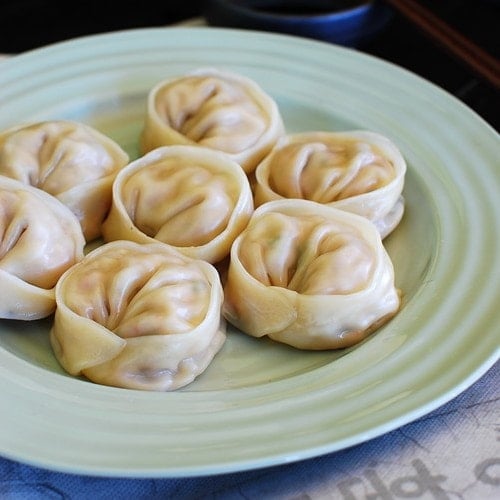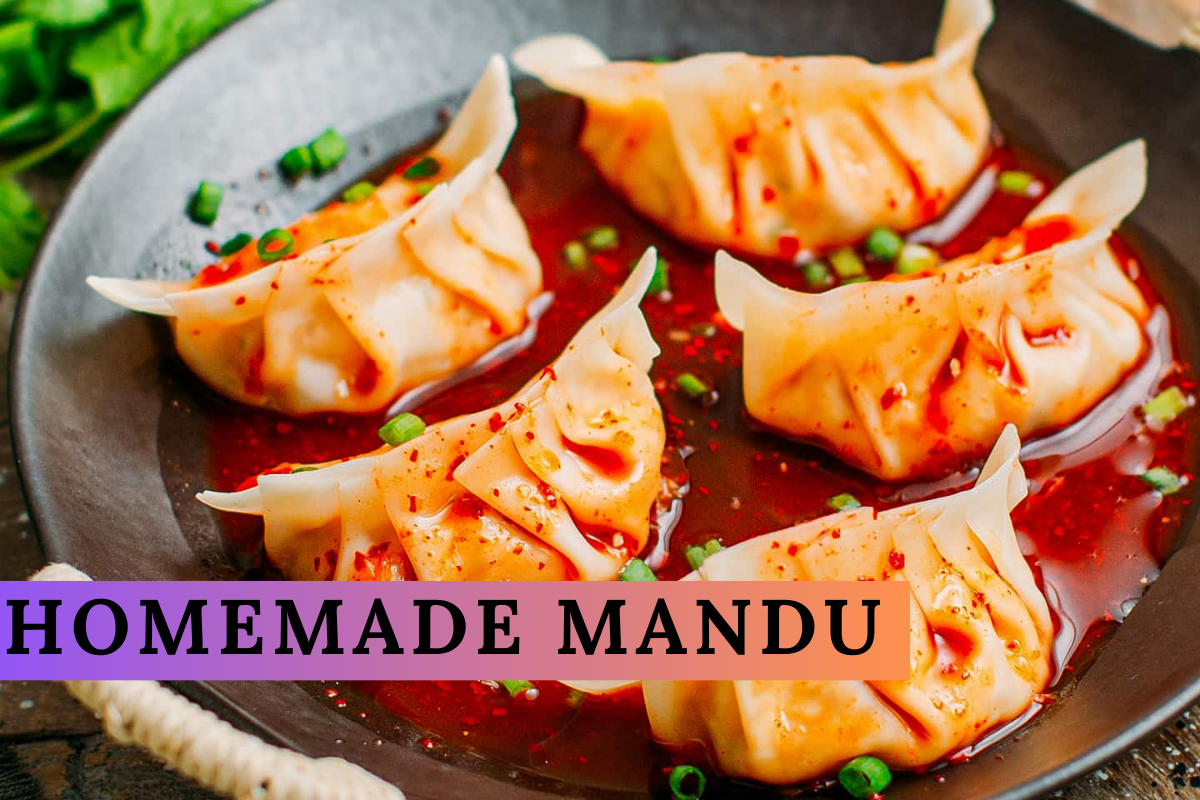Ingredients:

Dough:
- 2 cups all-purpose flour
- 1/2 cup water (adjust as needed)
- 1/2 teaspoon salt
Filling:
- 1/2 pound ground pork (or beef, or a mix of both)
- 1/2 cup finely chopped napa cabbage
- 1/4 cup finely chopped onion
- 1/4 cup finely chopped green onions
- 1/4 cup finely chopped carrots
- 2 cloves garlic, minced
- 1 teaspoon grated ginger
- 1 tablespoon soy sauce
- 1 tablespoon sesame oil
- 1 teaspoon sugar
- 1 teaspoon salt
- 1/2 teaspoon black pepper
- 1/2 teaspoon sesame seeds (optional)
- 1 beaten egg (for binding)
Dipping Sauce:
- 2 tablespoons soy sauce
- 1 tablespoon rice vinegar
- 1 teaspoon sesame oil
- 1/2 teaspoon sugar
- 1/2 teaspoon red pepper flakes (optional)
- 1 teaspoon chopped green onions
Instructions:
Making the Dough:
- In a large bowl, combine the flour and salt. Gradually add water, mixing until a dough forms.
- Knead the dough on a floured surface for about 5-10 minutes until smooth.
- Cover with a damp cloth and let it rest for at least 30 minutes.
Preparing the Filling:
- In a large bowl, combine the ground pork, chopped napa cabbage, onion, green onions, carrots, garlic, and ginger.
- Add the soy sauce, sesame oil, sugar, salt, black pepper, and sesame seeds if using. Mix well.
- Add the beaten egg to the mixture to help bind the ingredients together.
Assembling the Mandu:
Watch here
- Roll the rested dough into a long log and cut it into small pieces (about 1 inch each).
- Roll each piece into a ball and then flatten into a thin, round wrapper about 3-4 inches in diameter.
- Place about a tablespoon of filling in the center of each wrapper.
- Fold the wrapper in half to create a half-moon shape, and pinch the edges to seal. You can pleat the edges for a traditional look.
Cooking the Mandu:
- Steaming: Place the mandu in a steamer and steam for about 10-12 minutes.
- Boiling: Bring a pot of water to a boil and cook the mandu for about 5-7 minutes, until they float to the top.
- Pan-frying: Heat a tablespoon of oil in a pan over medium heat. Place the mandu in the pan and cook until the bottoms are golden brown, then add a little water (about 1/4 cup), cover, and steam until the water evaporates (about 5 minutes).
Making the Dipping Sauce:
- In a small bowl, combine soy sauce, rice vinegar, sesame oil, sugar, red pepper flakes, and chopped green onions.
- Stir until the sugar is dissolved.
Serving:
- Serve the mandu hot with the dipping sauce on the side.
Tips:
:max_bytes(150000):strip_icc()/Simply-Recipes-Mandu-FINAL-07-0efa3f32d68d41dbb3b1324f08c34804.jpg)
- You can make a large batch and freeze the uncooked mandu for later use. Lay them out on a baking sheet to freeze individually before transferring to a freezer bag.
- Feel free to experiment with different fillings, such as tofu and vegetables for a vegetarian option.
Enjoy your homemade mandu!
Benefits of Eating Mandu
Mandu, beyond being delicious and versatile, offer several nutritional and practical benefits. Here are some of the key benefits:
Nutritional Benefits
- Balanced Nutrition: Mandu typically include a mix of protein, vegetables, and carbohydrates, providing a well-rounded meal. The protein from meat or tofu, combined with vitamins and minerals from vegetables, makes for a nutritious option.
- Low in Fat (Steamed or Boiled): When steamed or boiled, mandu are relatively low in fat, making them a healthier choice compared to many fried foods.
- Rich in Fiber: The vegetables used in the filling, such as cabbage, onions, and carrots, add fiber to the diet, which aids digestion and promotes a healthy gut.
- Versatility in Ingredients: Mandu can be customized with various fillings to suit dietary preferences and nutritional needs. For example, they can be made vegetarian, vegan, or gluten-free with the right ingredients.
Practical Benefits
- Ease of Preparation: While making mandu from scratch can be a bit time-consuming, it is relatively straightforward and can be a fun activity for families or groups. Additionally, pre-made mandu wrappers can save time.
- Freezer-Friendly: Mandu can be made in large batches and frozen, providing a quick and convenient meal option for busy days. They can be cooked directly from frozen, which is a great time-saver.
- Versatile Cooking Methods: Mandu can be steamed, boiled, or pan-fried, offering flexibility in how they are prepared and enjoyed. This allows for variety in texture and flavor.
- Portability: Mandu make a great snack or meal that can be easily packed for lunches or picnics. They are also a popular choice for bento boxes and other portable meals.
- Cultural Experience: Making and eating mandu can be an educational and enjoyable way to explore Korean culture and cuisine. It’s a dish that brings people together, whether making them as a family or sharing them with friends.
Frequently Asked Questions (FAQs) about Mandu
1. What is the difference between mandu and other types of dumplings?
Mandu are Korean dumplings, which can be filled with a variety of ingredients such as ground meat, tofu, vegetables, and seasonings. While similar to other dumplings like Chinese jiaozi, Japanese gyoza, and Tibetan momos, mandu have unique flavor profiles and are often seasoned with ingredients like soy sauce, sesame oil, garlic, and ginger.
2. Can mandu be made vegetarian or vegan?
Yes, mandu can easily be made vegetarian or vegan by using tofu, mushrooms, and a variety of vegetables as fillings. Simply replace any meat ingredients with plant-based alternatives.
3. How do I store leftover mandu?
Cooked mandu should be stored in an airtight container in the refrigerator and can last for up to 3 days. Uncooked mandu can be frozen by placing them on a baking sheet to freeze individually before transferring them to a freezer bag. They can be cooked directly from frozen without needing to thaw.
4. What dipping sauces go well with mandu?
A classic dipping sauce for mandu includes soy sauce, rice vinegar, sesame oil, and a pinch of sugar. You can also add garlic, green onions, and red pepper flakes for extra flavor. Other options include a mix of soy sauce and chili oil or a simple soy sauce and vinegar blend.
5. What are some common fillings for mandu?
Common fillings for mandu include:
- Ground pork or beef
- Finely chopped napa cabbage
- Onions and green onions
- Carrots
- Garlic and ginger
- Tofu (for vegetarian/vegan versions)
- Glass noodles (dangmyeon)
6. How do I prevent the mandu wrappers from drying out while making them?
To prevent the mandu wrappers from drying out, cover them with a damp cloth while you work. This will keep them pliable and easier to fold and seal.
7. Can I use store-bought wrappers for mandu?
Yes, you can use store-bought dumpling wrappers to save time. They are usually found in the refrigerated or frozen section of Asian grocery stores. Just make sure to follow the instructions for handling and storing them properly.
8. What is the best way to cook frozen mandu?
Frozen mandu can be cooked directly from the freezer. They can be steamed for about 12-15 minutes, boiled for 7–10 minutes until they float, or pan-fried by first browning them in a bit of oil and then adding water to steam them through (cover the pan while steaming).
9. Are there different types of mandu?
Yes, there are several types of mandu, including:
- Gun-mandu: Pan-fried mandu with a crispy exterior.
- Jjin-mandu: Steamed mandu with a tender texture.
- Mul-mandu: Boiled mandu, often served in soups or broths.
- Kimchi-mandu: Mandu filled with kimchi for a spicy, tangy flavor.
10. Can I make gluten-free mandu?
Yes, gluten-free mandu can be made by using gluten-free wrappers, which are often made from rice flour or other gluten-free flours. Be sure to check the ingredients of all components, including sauces, to ensure they are gluten-free.
Mandu are more than just a tasty treat; they offer a host of nutritional and practical benefits that make them a great addition to any meal plan. Whether you’re enjoying them for their balanced nutrition, ease of preparation, or the cultural experience, mandu are a delicious way to diversify your diet.
